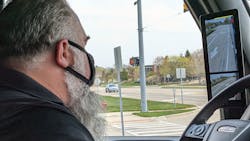Tyson Foods, one of the largest food product private fleets in the U.S., isn’t usually an early adopter of new transportation technology. Still, the fleet couldn’t resist the benefits of the Stoneridge MirrorEye system.
“We are not usually on the forefront of new technology, but MirrorEye was pretty much our first exception,” Philip Van Hook, Tyson Foods managing director of transportation operations, told FleetOwner. “We got involved with MirrorEye before they really had a full platform in the United States. We thought it was a great technology, and we’ve gotten nothing but great feedback from our drivers on it.”
The Stoneridge MirrorEye Camera Monitor System (CMS) replaces traditional rear and side-view mirrors with integrated externally mounted high-definition cameras that feed to large HD interior screens. The cameras can move as tractor-trailers make turns, so the in-cab displays show off the optimal view, which is wider than traditional side-view mirrors. With MirrorEye, the truck driver can see where the trailer is in relation to the curb or other vehicles and obstacles. It also cuts down on traditional blind spots.
MirrorEye was the first CMS to receive a federal exemption from the Federal Motor Carrier Safety Administration (FMCSA), allowing trucks equipped with the technology to operate on roadways without conventional mirrors.
According to FMCSA, blind spots contribute to one-third of all commercial vehicle-related crashes. And two significant contributors of blindspots are the large side-view mirrors and their housing. Stoneridge notes that the blindspots of traditional heavy-duty tractor mirrors can block up to 36 feet of the roadway and traffic to the right and left at a four-way intersection.
This spring, Tyson had MirrorEye on 75 trucks with plans to eventually deploy it across its private fleet, which has more than 4,000 total vehicles. According to Stoneridge, Tyson is the largest refrigerated fleet to adopt MirrorEye. An FMCSA study found that MirrorEye’s technology could reduce blindspot CV accidents by about 30%. Stoneridge’s actual fleet data indicates it could reduce blindspot crashes by 40% and reduce accident costs up to 50%.
“Drivers report it not only helps them see around their space but more importantly when they are backing and turning, they can always find the tail of their trailer and know if there is something they are about to run into or somebody is about to get in their space,” Van Hook said.
Several years ago, Van Hook and his team “piled into a big, humongous Peterbilt pulling a trailer” for a MirrorEye demonstration. “He was weaving in and out of cars in a neighborhood market—just sliding in and out between cars—and he never lost his trailer,” he said.
As Van Hook and others from Tyson watched the high-definition “mirror” displays inside the cab, all he could think was: “This stuff is amazing.”
“As we put it on our trucks to test, grizzled drivers and brand new drivers that were going through the testing all came back and said that the [MirrorEye)] technology makes me a better driver and a safer driver. We are moving forward with implementing that across our entire fleet as we go through the trade cycles.”
Along with improving driver ergonomics, Van Hook said the system really shines in lousy weather. “Sometimes when it’s raining really hard, these drivers can barely see their mirrors to know where they’re backing up and how they’re backing up,” he explained. “And this technology wipes that away: the fog, the rain, the snow. It’s such a clear picture those drivers are able to understand their surroundings very well.”
About the Author
Josh Fisher
Editor-in-Chief
Editor-in-Chief Josh Fisher has been with FleetOwner since 2017. He covers everything from modern fleet management to operational efficiency, artificial intelligence, autonomous trucking, alternative fuels and powertrains, regulations, and emerging transportation technology. Based in Maryland, he writes the Lane Shift Ahead column about the changing North American transportation landscape.

